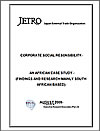BOP Report(Bottom of the Pyramid)
All data are collected in the Fiscal Year of 2008-2009.
12. BOP Experiments in the Field
“Furious activity is no substitute for understanding,” wrote H. H. Williams. This is what the BOP space feels like at present. Clearly, much work needs to be done to develop better analytical tools, empirical research, and operational models to understand who is doing what, where, how, why, and with whom—and then to evaluate what is working and what is not. This is important because the cost of evaluating the quality of these projects is currently quite high. But it is also complicated—experimentation is happening all over the world, by a wide range of organizations and actors both large and small, often in far-flung and culturally challenging places. Fortunately, the empirical foundation supporting the BOP logic is starting to be built by academic hubs like the BOP Lab at the University of North Carolina. However, we are still a few years away from seeing any results.
Meanwhile, sitting at the crosshairs of both private and public spheres, we are witnessing a Cambrian explosion of activity within the social or citizen sector—a sector now comprising millions of organizations around the world that have emerged to fill certain social needs and value vacuums. David Bornstein, author of the inspiring forthcoming book, How to Change the World,5 likens the birth of this sector to the creation of the commercial sector after the Middle Ages, when the barriers to entrepreneurship fell as the feudal and guild system, which restricted entry, collapsed. It took another 200 years to create the structures, institutions, and norms that support entrepreneurship and business—things we take for granted today like limited liability, joint stock ownership, operating standards, and formal management education. Similarly, the barriers to becoming a social entrepreneur are dropping, as the public sector devolves and deregulates and the private sector’s role shifts as well.
We are also just starting to create the support structures for this sector to thrive, with experiments in venture philanthropy and a shifting perception of social entrepreneurship as a viable career path. As increased competition within this sector weeds out the bad ideas from the good, it will become a fertile place to look for future BOP ideas, experiments, organizational models, and trends. The social innovation that happens there is almost certain to have implications and applications for both private and public sectors. Bornstein also sees a convergence between business entrepreneurs and social entrepreneurs; the latter know how to manage a particular client set and distribution network, while the former have production capacity and know-how.
目次
- 1. Reperceiving Business from the Bottom Up
- 2. Bop in Brief
- 3. Four Consumer Tiers
- 4. The Invisible Opportunity
- 5. Tier 4 Pioneer
- 6. Creating Buying Power
- 7. Shaping Aspirations
- 8. Improving Access
- 9. Tailoring Local Solutions
- 10. Putting It All Together
- 11. A Common Cause
- 12. BOP Experiments in the Field
- 13. A BOP Typology
- 14. What's Next for BOP?
- 15. How to Get Started: The Conceptual Framework for BOP Innovation
- 16. BoP Conferences
- 17. Case Studies and Relevant Reference Material
- Bibliography




